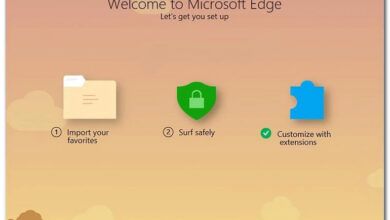2 Methods ‘Enable/Disable Adobe Flash player on Microsoft Edge’
Adobe Flash player is automatically integrated with the Microsoft Edge browser. The beauty of this integration is that the Flash Player gets automatically updated via Windows Updates, so you don’t have to worry about running into compatibility problem caused by an outdated version.
However, since it launched, Windows Edge went through some changes related to how it treats Flash content. First, starting with Windows 10 build 15002, Microsoft Edge started blocked untrusted Flash content by default (or until the users choose to play it). This was indeed a measure that would provide better security and performance while leaving the choice to end user. You had the option to allow Adobe Flash to run just once on a particular site or indefinitely.
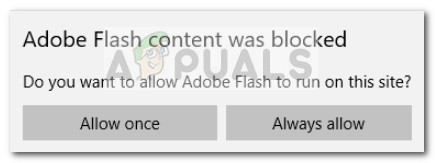
Then with Windows 10 build 15042, the Updated Click-to-Run experience dialog was added in the URL bar in order to make it obvious when the Flash content is being blocked. Now if you click on the puzzle icon you can allow Flash to run just this time or every time you return to the same web page.
![]()
But what do you do if you clicked the Always allow button only to realize that the content isn’t as safe as you first thought? Or the other way around?
Fortunately, there are a couple of ways that will allow you to disable or enable Flash content on Microsoft Edge. Below you have two different methods that will allow you to change the default behavior on how Flash content gets treated. Please follow any method that seems more convenable to you.
Method 1: Enabling or Disabling Adobe Flash Player from Microsoft Edge Settings
This is the native way that is both more intuitive and a lot quicker than Method 2. Keep in mind that this change will apply to all pages that you visit with Microsoft Edge, not just the page that you’re currently on when following the steps below.
Here’s a quick guide on how to disable or enable Flash Player from Microsoft Edge settings:
- Open Microsoft Edge conventionally via the taskbar, desktop icon or from the Start menu. Additionally, you can open it by opening a Run box (Windows key + R), typing “microsoftedge.exe” and typing Enter.
- Inside the Microsoft Edge app, go over to the top-right corner and click on the action button (three-dot icon). From the action menu, click on Settings.

- In the Settings menu, scroll down to the bottom and click on View Advanced settings.
- In the Advanced settings menu, use the toggle under Use Adobe Flash Player to either disable or enable flash content – depending on your needs.
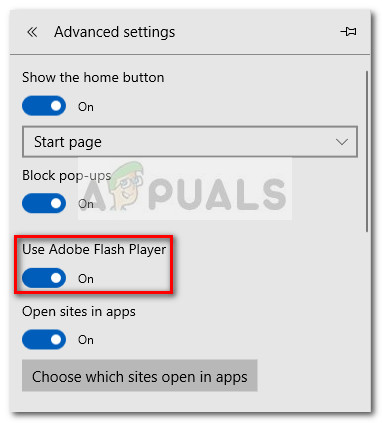
- That’s it. Keep in mind that in order to force the new setting to apply to the web page that you’re currently visiting you’ll need to refresh the page.
If you are looking for a different way of disabling or enabling Flash content on Microsoft Edge, move over to Method 2.
Method 2: Enabling or Disabling Flash Player on Microsoft Edge via Registry Editor
If you fancy a more technical approach, you can also modify the way Microsoft Edge treats Flash content via Registry Editor. While bad registry changes might damage your system if you’re not careful, following the procedure below carefully will eliminate the risk of any damage to the registry.
Here’s a quick guide on how to enable or disable Flash player by editing the Registry via Registry Editor:
- Press Windows key + R to open up a Run box. Then, type “regedit“, hit Enter, then choose Yes at the UAC (User Account Control) to open Registry Editor with elevated privileges.
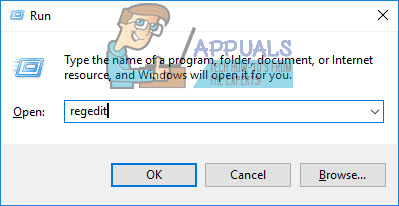
- Inside Registry Editor, use the ribbon at the top to choose File > Export. Then, set an appropriate location and your name for the Registry backup and hit the Save button. This step is done in order to ensure that you have a backup plan in case things go wrong, so please don’t skip it.
 Note: In case things do go wrong and you need to repair your Registry, go to File > Import and select the backup that you previously created.
Note: In case things do go wrong and you need to repair your Registry, go to File > Import and select the backup that you previously created. - Once the backup is in place, use the left-pane to navigate to the following location:
HKEY_CURRENT_USER \ SOFTWARE \ Classes \ Local Settings \ Software\Microsoft\Windows\CurrentVersion\AppContainer \ Storage \ microsoft.microsoftedge_8wekyb3d8bbwe \ MicrosoftEdge \ Addons
- Once you reach the above-specified location, move over to the right pane, right-click on a free space and choose New > Dword (32-bit) Value data and name it FlashPlayerEnabled.
- Then, double-click on FlashPlayerEnabled, set the Base to Hexadecimal and the Value data to 1 and hit OK to save the changes. This will enable the Flash Player.
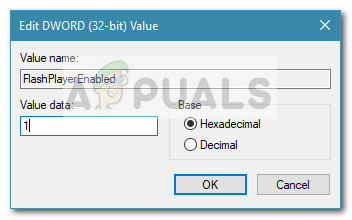
- Once the FlashPlayerEnabled DWORD has been created, close the Registry Editor and reboot your computer to force the changes to take effect.
Note: If you ever want to disable the Flash Player from Microsoft edge, return to the key specified above and set the value of FlashPlayerEnabled to 0.




